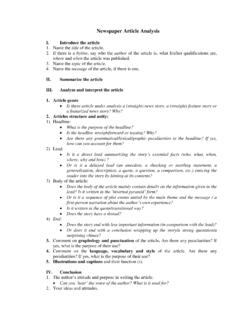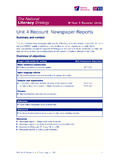Transcription of Lecture 1 BASIC NOTIONS OF CROSS-CULTURAL ... - bsu.by
1 Lecture 1 BASIC NOTIONS OF CROSS-CULTURAL COMMUNICATION 1. The concept of CROSS-CULTURAL communication. 2. CROSS-CULTURAL communication as a field of study of: anthropology, psychology, linguistics, communication and cultural studies. 3. Communication as process. Language as a powerful means of communication. 4. The concept of culture. 5. Communication types: direct and indirect communication. 6. Pragmatics of communication. 7. The BASIC units of verbal communication: texts and speech acts. CROSS-CULTURAL communication CROSS-CULTURAL communication refers to interpersonal communication and interaction across different cultures. This has become an important issue in our age of globalization and internationalization.
2 Effective CROSS-CULTURAL communication is concerned with overcoming cultural differences across nationality, religion, borders, culture and behavior. The term CROSS-CULTURAL generally used to describe comparative studies of cultures. Culture is the BASIC concept of CROSS-CULTURAL communication. Merriam-Webster's Collegiate Dictionary defines culture as 'the integrated pattern of human knowledge, belief and behavior that depends upon man's capacity for learning and transmitting knowledge to succeeding generations'. Another usage in the same dictionary stresses the social aspect of culture and defines it as 'the customary beliefs, social forms, and material traits of a racial, religious or social group'.
3 The OED, in a similar vein, states that culture is ' a particular form, stage, or type of intellectual development or civilization in a society; a society or group characterized by its distinctive customs, achievements, products, outlook, etc.' It almost goes without saying that there can hardly be any learning or transmitting knowledge or intellectual development without language. Nor can a society or a group function without language. Culture not only dictates who talks what, to whom, how, and why, but also helps to determine how communication proceeds, and how messages transmit the intended meanings. CROSS-CULTURAL communication the comparison of communication across cultures.
4 Although CROSS-CULTURAL communication needs: Listening Skills Their emphasis usually lies on being a competent speaker, listening is a key skill that many business personnel do not exercise enough. For CROSS-CULTURAL communication, attentive listening is critical to be able to understand meanings, read between the lines and enable to empathize with the speaker. Speaking Skills Listening and speaking must work in tandem for effective CROSS-CULTURAL communication. Speaking well is not about accent, use of grammar and vocabulary or having the gift of the gab. Rather, CROSS-CULTURAL communication is enhanced through positive speech such as encouragement, affirmation, recognition and phrasing requests clearly or expressing opinions sensitively.
5 Observation Large amounts of CROSS-CULTURAL information can be read in people's dress, body language, interaction and behavior. Be aware of differences with your own culture and try to understand the roots of behaviors. Asking questions expands your CROSS-CULTURAL knowledge. Patience People need to recognize and understand that sometimes CROSS-CULTURAL differences are annoying and frustrating. In these situations, patience is definitely a virtue. Through patience, respect is won, and CROSS-CULTURAL understanding is enhanced. Flexibility Flexibility, adaptability and open-mindedness are the route to successful CROSS-CULTURAL communication. Understanding, embracing and addressing CROSS-CULTURAL differences leads to the breaking of cultural barriers, which results in better lines of communication, mutual trust and creative thinking.
6 Following these five CROSS-CULTURAL communication needs will allow us to improve lines of communication and better CROSS-CULTURAL awareness and successful CROSS-CULTURAL relationships. CROSS-CULTURAL communication as a field of study of: anthropology, psychology, linguistics, communication and cultural studies CROSS-CULTURAL communication (also frequently referred to as intercultural communication) is a field of study that looks at how people from differing cultural backgrounds try to communicate. CROSS-CULTURAL communication as a field of study is a combination of many other scholarly fields. These fields include anthropology, psychology, linguistics, communication and cultural studies.
7 The term culture is taken from anthropology, wherein it embraces the entire way of life of members of a community insofar as it is conditioned by that membership. Anthropologists most commonly use the term "culture" to refer to the universal human capacity to classify, to codify and communicate their experiences symbolically. Linguistic anthropology is the comparative study of ways in which language reflects and influences social life. It explores the many ways in which language practices define patterns of communication, formulate categories of social identity and group membership, organize large-scale cultural beliefs and ideologies, and, in conjunction with other forms of meaning-making, equip people with common cultural representations of their natural and social worlds.
8 Psychology studies human behavior. Psychological applications of cross- cultural / multicultural communications work on the primes that all human beings essentially communicate on similar definable levels, and these definitions can be predictable and applied to cultivate a Borderless Communication Foundation . Psycholinguistics or psychology of language is the study of the psychological and neurobiological factors that enable humans to acquire, use, comprehend and produce language. Language and our thought-grooves are inextricably interwoven, are, in a sense, one and the same. As there is nothing to show that there are significant racial differences in the fundamental conformation of thought, it follows that the infinite variability of linguistic form, another name for the infinite variability of the actual process of thought, cannot be an index of such significant racial differences.
9 Linguistics is the scientific study of human language. Linguistics can be broadly broken into three categories or subfields of study: language form, language meaning, and language in context. Linguistics is concerned largely with finding and describing the generalities and varieties both within particular languages and among all languages that are powerful means of CROSS-CULTURAL communications. There are two fields of linguistics, which are essential for CROSS-CULTURAL communication. They are ethnolinguistics and sociolinguistics. Ethnolinguistics or cultural linguistics is a field of linguistics, which studies the relationship between language and culture, and the way different ethnic groups perceive the world.
10 It is the combination between ethnology and linguistics. The former refers to the way of life of an entire community all the characteristics which distinguish one community from the other. Those characteristics make the cultural aspects of a community or a society. Communication studies is an academic field that deals with processes of communication, commonly defined as the sharing of symbols over distances in space and time. Communication is a fundamental process by which patterns in a medium move through time and space. Communication ensures continuity in the development of culture. Every new generation begins its work of learning from the point where the previous generation left off.






